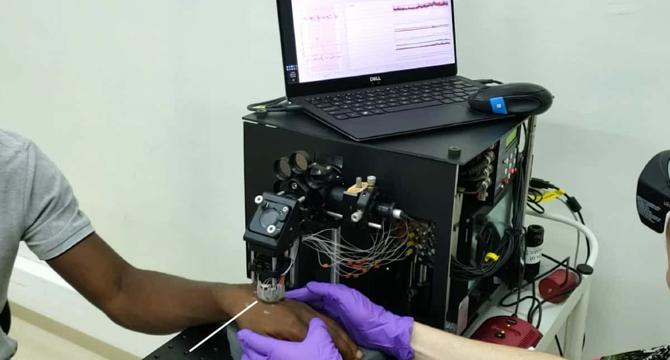Physicsworld
1M
140

Image Credit: Physicsworld
From melanoma to malaria: photoacoustic device detects disease without taking a single drop of blood
- Researchers from the University of Arkansas have collaborated with Cameroon scientists to develop the Cytophone, a non-invasive device that can detect and identify malaria-infected red blood cells within seconds through a small probe placed on the back of a hand, and without requiring a single drop of blood sample.
- The device is the first of its kind to use photoacoustic flow cytometry (PAFC) technology to detect haemozoin, an iron crystal that accumulates in red blood cells infected with malaria parasites.
- PAFC delivers low-energy laser pulses through a subject's skin into a blood vessel, then records the thermoacoustic signals generated by absorbers in circulating blood to identify the infected cells.
- Clinical testing of the Cytophone in 30 Cameroonian adults with uncomplicated malaria yielded promising results, with a 95% sensitivity rate at the first visit thanks to Cytophone detecting the most common and deadliest species of malaria.
- The study's authors suggest that the device also has potential to diagnose other diseases, such as circulating blood clots in stroke patients, and will be incorporated into a wearable platform for low-cost continuous health monitoring.
- The Cytophone is a breakthrough device allowing for non-invasive, rapid, label-free and safe in vivo diagnosis of malaria.
- The technology works by delivering low-energy laser pulses through the skin into a blood vessel and recording the thermoacoustic signals generated by absorbers in circulating blood.
- The Cytophone prototype uses haemozoin, an iron crystal that accumulates in red blood cells infected with malaria parasites, as a potential diagnostic target.
- Compared with microscopy-based detection, the Cytophone demonstrated 95% sensitivity at the first visit and 90% sensitivity during the follow-up period, with 69% specificity and an area under the ROC curve of 0.84.
- Cytophone has the potential to be an affordable, breakthrough device used for non-invasive, rapid, label-free and safe in vivo diagnoses of not just malaria, but also other diseases such as blood clots and cancer.
Read Full Article
8 Likes
For uninterrupted reading, download the app